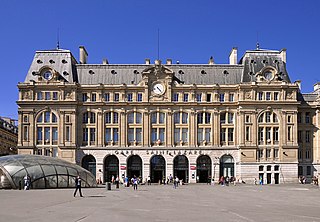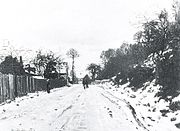
Oscar-Claude Monet was a French painter and founder of impressionism painting who is seen as a key precursor to modernism, especially in his attempts to paint nature as he perceived it. During his long career, he was the most consistent and prolific practitioner of impressionism's philosophy of expressing one's perceptions of nature, especially as applied to plein air (outdoor) landscape painting. The term "impressionism" is derived from the title of his painting Impression, soleil levant, which was first exhibited in the so-called "exhibition of rejects" of 1874–an exhibition initiated by Monet and like-minded artists as an alternative to the Salon.

The Gare Saint-Lazare, officially Paris Saint Lazare, is one of the seven large mainline railway station terminals in Paris, France. It was the first train station built in Paris, opening in 1837. It mostly serves train services to western suburbs, as well as intercity services toward Normandy using the Paris–Le Havre railway. Saint-Lazare is the third busiest station in France, after the Gare du Nord and Gare de Lyon. It handles 290,000 passengers each day. The current station building opened in 1889 and was designed by architect Juste Lisch; the maître d'œuvre was Eugène Flachat.

Eugène Louis Boudin was one of the first French landscape painters to paint outdoors. Boudin was a marine painter, and expert in the rendering of all that goes upon the sea and along its shores. His pastels, summary and economic, garnered the splendid eulogy of Baudelaire; and Corot called him the "King of the skies".

Johan Barthold Jongkind was a Dutch painter and printmaker. He painted marine landscapes in a free manner and is regarded as a forerunner of impressionism.

Haystacks is the common English title for a series of impressionist paintings by Claude Monet. The principal subject of each painting in the series is stacks of harvested wheat. The title refers primarily to a twenty-five canvas series which Monet began near the end of the summer of 1890 and continued through the following spring, though Monet also produced five earlier paintings using this same stack subject. A precursor to the series is the 1884 Haystack Near Giverny.

The Garden at Sainte-Adresse is a painting by the French impressionist painter Claude Monet.. The painting was acquired by the Metropolitan Museum of Art after an auction sale at Christie's in December 1967, under the French title La terrasse à Sainte-Adresse. The painting was exhibited at the 4th Impressionist exhibition, Paris, April 10–May 11, 1879, as no. 157 under the title Jardin à Sainte-Adresse.

The Regatta at Sainte-Adresse is an oil-on-canvas painting by the impressionist painter Claude Monet. It was painted in 1867 and is owned by the Metropolitan Museum of Art.

Blanche Hoschedé Monet was a French painter who was both the stepdaughter and the daughter-in-law of Claude Monet.

Snow at Argenteuil is an oil-on-canvas landscape painting by the Impressionist artist Claude Monet. It is the largest of no fewer than eighteen works Monet painted of his home commune of Argenteuil while it was under a blanket of snow during the winter of 1874–1875. This painting—number 352 in Wildenstein's catalogue of the works of Monet—is the largest of the eighteen. The attention to detail evident in the smaller paintings is less evident in this larger picture. Instead, Monet has rendered large areas of the canvas in closely like tones and colours of blue and grey. The application of smaller strokes of greens, yellows, reds and darker blues breaks up these large expanses, and the almost choreographed dispersal of these various colours helps bind the picture together. Paint at the depicted road surface is thicker than elsewhere in the painting, and impasto is suggestive of the feel of disturbed snow.

Adolphe-Félix Cals was a French portrait, genre, and landscape painter.

The Magpie is an oil-on-canvas landscape painting by the French Impressionist Claude Monet, created during the winter of 1868–1869 near the commune of Étretat in Normandy. Monet's patron, Louis Joachim Gaudibert, helped arrange a house in Étretat for Monet's girlfriend Camille Doncieux and their newborn son, allowing Monet to paint in relative comfort, surrounded by his family.

Boulevard des Capucines is the title of two oil-on-canvas paintings depicting the famous Paris boulevard by French Impressionist artist Claude Monet, created between 1873-1874. One version is vertical in format and depicts a snowy street scene looking down the boulevard towards the Place de l'Opéra. The other version is a horizontal composition and shows the same street on a sunny winter day; it is housed at The Pushkin State Museum of Fine Arts in Moscow and is believed to be the version that was exhibited at the first Impressionist exhibit in 1874. Monet painted the works from the photography studio of Félix Nadar at 35 Boulevard des Capucines. The elevated vantage point and loose brushstrokes allow the audience to see the commotion of the boulevard from a position high above street level. Certain aspects of the paintings have parallels in the photography of Monet's day and in Japanese prints, which may have influenced Monet.
Impressionists in Winter: Effets de Neige was a late 20th-century art exhibition featuring 63 Impressionist winter landscape paintings by artists Claude Monet, Pierre-Auguste Renoir, Camille Pissarro, Alfred Sisley, Gustave Caillebotte, and Paul Gauguin.

The depiction of winter landscapes in Western art begins in the 15th century. Wintry and snowy landscapes are very rarely seen in early European painting since most of the subjects were religious. Painters avoided landscapes in general for the same reason. The first depictions of snow began to occur in the 15th and 16th centuries. Paintings that feature snow as a theme are mostly landscapes, even if some of these works involve religious or even fantasy landscapes. Most of these winter landscapes in art history are plein-air depictions of winter scenes, using the quality of gray winter light to create the special winter atmosphere. Depiction of snow in Europe is essentially a northern European theme.

Skaters in the Bois de Boulogne is an oil-on-canvas landscape painting by the French artist Pierre-Auguste Renoir, created during the winter of 1868. The painting depicts a snowscape with many Parisians, young and old, spending leisure time on a frozen park lake. Due to Renoir's strong dislike of cold temperatures and snow, the piece is one of his few winter landscapes.

Arrival of the Normandy Train, Gare Saint-Lazare, also known as The Railway Station of Saint Lazare in Paris, is a c. 1877 oil-on-canvas painting by Claude Monet. It is in the permanent collection of the Art Institute of Chicago.

Atelier de la rue Furstenberg is an 1866 oil-on-canvas painting by the 19th century French impressionist artist Frédéric Bazille, which has been in the collection of the Musée Fabre in Montpellier, France since 1985.

A Cart on the Snowy Road at Honfleur is an oil-on-canvas snowscape painting by French impressionist Claude Monet. The painting depicts a man on a wooden cart travelling along a snow-laden road in Honfleur.

The Beach at Honfleur is an oil-on-canvas painting by French impressionist Claude Monet. The painting depicts a beach on the Côte de Grâce with sailboats, the hospital of Honfleur, and a lighthouse in the distance. In the foreground, a solitary figure in a blue smock stands on the beach. The painting was created with short, thick brushstrokes, typical of Impressionism.

The Train in the Snow, or Le train dans la neige, is a landscape painting by the French Impressionist artist Claude Monet. The work depicts a train surrounded by snow at the Argenteuil station in France. Art historians see the work as a significant example of Monet's efforts to integrate nature and industry in his work. Many historians believe that Monet, out of all of the notable nineteenth century artists, made the most paintings of trains in his lifetime.





















